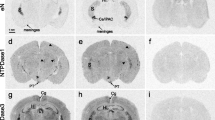Summary
Hydroxyindole O-methyltransferase (HIOMT)-immunoreactive cells and melatonin synthesis were demonstrated in bovine epithalamus (including the pineal gland) with monoclonal antibodies and cRNA probes to HIOMT. The HIOMT-immunoreactive product was present in the cytoplasm of pinealocytes. All identifiable pinealocytes were clearly labeled in the pineal gland. The expression of the HIOMT gene was first identified in pinealocyte cytoplasm by in-situ hybridization (ISH). The distribution of the hybridization-positive cells in the pineal gland was compatible with that revealed by immunocytochemistry using the monoclonal antibody to HIOMT. In addition, HIOMT transcripts were found in the medial habenular nucleus, and the habenular and posterior commissure; they may correspond to S-antigen-immunoreactive cells demonstrated in the same regions of the hamster and the mouse. In these regions, the hybridization-positive cells did not exhibit HIOMT-immunoreactivity; thus, cells devoid of immunoreactivity may synthesize but rapidly transport the newly synthesized proteins. These results indicate (1) that the conversion of N-acetylserotonin into melatonin takes place in the cytoplasm of pinealocytes, (2) that some epithalamic cells in the habenular area may synthesize melatonin, and (3) that melatonin may act as a chemical messenger in centrally directed processes, as shown by using S-antigen immunocytochemistry.
Similar content being viewed by others
References
Axelrod J (1974) The pineal gland: a neurochemical transducer. Science 184:1341–1348
Axelrod J, Weissbach H (1961) Purification and properties of hydroxyindole-O-methyltransferase. J Biol Chem 236:211–213
Clark S, Short R, Mark U (1985) Photoperiodism, melatonin and the pineal. Pitman, London
Deguchi T, Yokoyama E, Ichikawa T (1987) Monoclonal antibodies to hydroxyindole O-methyltransferase from bovine pineal gland. Mol Brain Res 2:89–98
Ekström P (1987) Photoreceptors and CSF-contacting neurons in the pineal organ of a teleost fish have direct axonal connections with the brain. An HRP-electron-microscopic study. J Neurosci 7:987–995
Ekström P, Foster RG, Korf HW, Schalken JJ (1987) Antibodies against retinal photoreceptor-specific proteins reveal axonal projections from the photosensory pineal organ in teleosts. J Comp Neurol 265:25–33
Hastings M (1986) Problems in pineal physiology. Nature 320:576–577
Ishida I, Obinata M, Deguchi T (1987a) Molecular cloning and nucleotide sequence of cDNA-encoding hydroxyindole O-methyltransferase of bovine pineal glands. J Biol Chem 262:2895–2899
Ishida I, Ohsako S, Nakane M, Deguchi T (1987b) Expression and characterization of hydroxyindole O-methyltransferase from a cloned cDNA in Chinese hamster ovary cells. Mol Brain Res 2:185–189
Korf HW, Oksche A, Ekström P, Gery I, Zigler JS Jr, Klein DC (1986) Pinealocyte projections into the mammalian brain revealed with S-antigen antiserum. Science 231:735–737
Korf HW, Sato T, Oksche A (1989) Reflections on the nature and connectivities of pinealocytes. In: Reiter RJ, Pang SF (eds) Advances in pineal research, vol 3. Libbey, London, pp 11–16
Korf HW, Sato T, Oksche A (1990) Complex relationships between the pineal organ and the medial habenular nucleus-pretectal region of the mouse as revealed by S-antigen immunocytochemistry. Cell Tissue Res 261:493–500
Kuwano R, Iwanaga T, Nakajima T, Masuda T, Takahashi Y (1983) Immunocytochemical demonstration of hydroxyindole O-methyltransferase (HIOMT), neuron-specific enolase (NSE) and S-100 protein in the bovine pineal gland. Brain Res 274:171–175
Oksche A (1986) Historical perspectives of photoneuroendocrine systems. In: O'Brien P, Klein DC (eds) Pineal and retinal relationships. Academic Press, Orlando, pp 1–13
Oksche A (1990) Historical perspective: the development of the concept of photoneuroendocrine systems. In: Klein DC, Moore RY, Reppert SM (eds) Suprachiasmatic nucleus: the mind's clock. Oxford University Press, Oxford (in press)
Rodríguez EM, Korf HW, Oksche A, Yulis CR, Hein S (1988) Pinealocytes immunoreactive with antisera against secretory glycoproteins of the subcommissural organ: a comparative study. Cell Tissue Res 254:469–480
Sternberger LA (1986) Immunocytochemistry, 3rd edn. Wiley, New York Chichester Brisbane
Author information
Authors and Affiliations
Rights and permissions
About this article
Cite this article
Sato, T., Deguchi, T., Ichikawa, T. et al. Localization of hydroxyindole O-methyltransferase-synthesizing cells in bovine epithalamus: immunocytochemistry and in-situ hybridization. Cell Tissue Res 263, 413–418 (1991). https://doi.org/10.1007/BF00327275
Accepted:
Issue Date:
DOI: https://doi.org/10.1007/BF00327275




